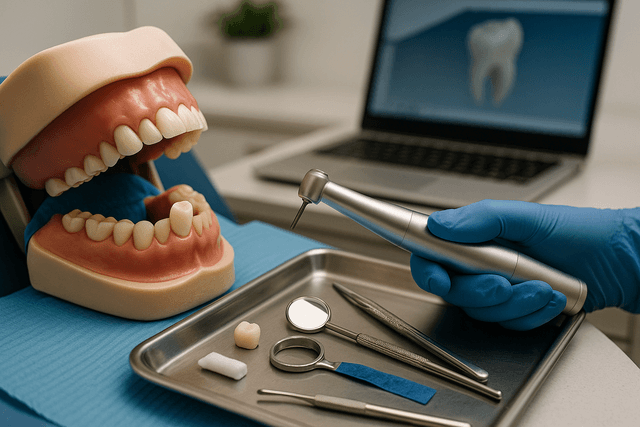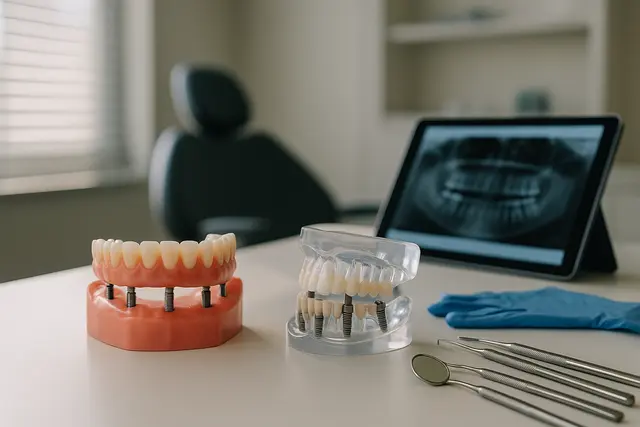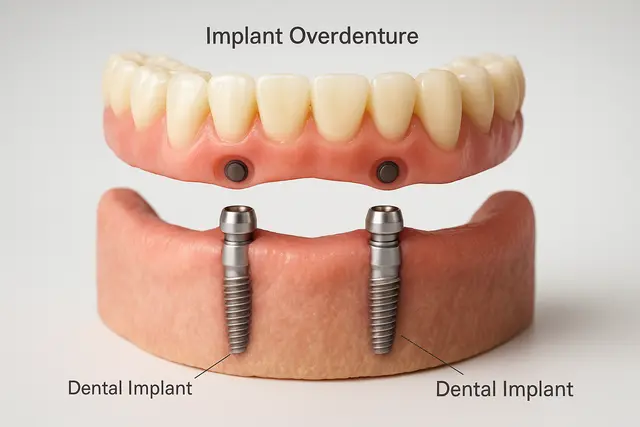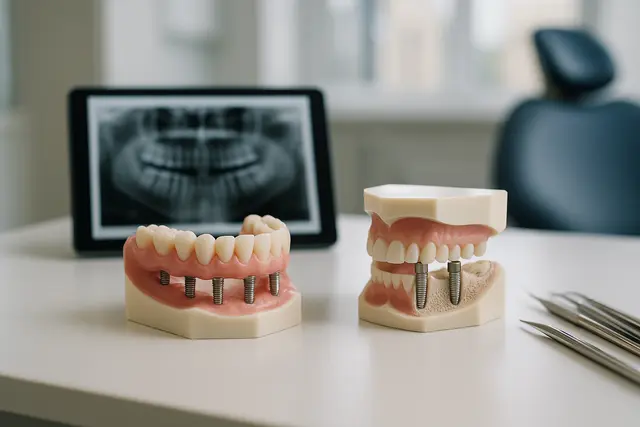Prosthodontics
5 min read
Aug 06, 2025
What Is Crown Prep? Full Process and Purpose Explained
A dental crown can restore the strength, shape, and appearance of a damaged tooth, but before you get one, there's an important step called crown preparation. If you're wondering what crown prep involves and why it's necessary, this guide breaks it down in a simple, stress-free way.

No one wants to hear the words “you need a crown.” But if your tooth is cracked, decayed, or just plain worn out, getting a crown can save the day (and your smile). And that first step? It’s something called crown prep, short for crown preparation. It might sound intense, but don’t worry. We’ll break it down in simple terms to help you feel confident before your appointment.
Why Your Tooth Might Need a Crown
Before diving into the crown prep process, let’s look at why someone might need a dental crown in the first place. If you’ve got a broken tooth, a decayed or damaged tooth, or you've had a root canal, your tooth structure may not be strong enough to hold up on its own anymore.
That’s where a crown comes in. A dental crown is a tooth-shaped cap that fits snugly over a prepared tooth. It restores strength, protects the underlying tooth, and, bonus, it looks just like your natural teeth (sometimes even better).
What to Expect During Dental Crown Preparation
So, how does your dentist prepare your tooth for a crown?
It starts with a little exam. Your dentist will examine the tooth and surrounding area, possibly take dental x-rays, and decide whether the tooth is a good candidate for a dental crown. If there’s still decay, they’ll clean it out first. If the tooth is severely broken, your dentist may need to build it up a bit before moving forward.
The goal is to prepare your tooth in a way that saves as much of your natural tooth as possible, while still making room for the crown.
Using a Dental Drill to Make Room for the Crown
Yes, we’re talking about the dental drill here, but don’t let that scare you. During tooth preparation, your dentist carefully removes a layer of your tooth using the drill to make room for the crown. The amount depends on the crown material, but they’ll take off just enough to ensure a strong, secure fit.
The idea is to shape the tooth so that when the crown is ready, it fits perfectly and doesn’t mess with your bite. It’s kind of like tailoring a suit, you want it snug but comfy.
Temporary Crown Placement While Your Crown Is Being Made
Once your tooth is shaped and ready, your dentist will take impressions (either digital or with a soft putty) to capture the exact shape of the prepared tooth and surrounding teeth. That way, the dental lab can design your crown with precision.
While you wait, your dentist will place a temporary crown to protect the tooth. It’s not as strong as the final version, but it does the job while your custom crown is being made. It helps you chew, smile, and live your life while keeping the crown in place and shielding the underlying tooth.
Types of Dental Crowns and Which One Might Work for You
When it comes to choosing the type of crown, it’s not one-size-fits-all. There are several types of crowns, and the best option depends on your needs and preferences. Some common choices include:
Porcelain or ceramic: These look the most like natural teeth
Metal: Super durable, though less popular for front teeth
Porcelain-fused-to-metal: A blend of strength and appearance
Resin: Affordable but may wear faster
Same-day crowns: Milled from a solid block using advanced tech, no waiting
The type of crown that’s right for you depends on where the tooth is, how visible it is when you smile, and how much chewing it’ll need to do.
How Crowns Are Made in the Dental Lab
After the impression of your tooth is complete, it gets sent to a dental lab where skilled technicians make the crown. This process can take a couple of weeks unless you're getting a same-day crown.
Every dental crown made this way is personalized. The lab matches it to your natural teeth in shape, size, and color, using the crown material best suited for your case. It’s a lot more artistic than most people realize!
The Final Step in Dental Crown Procedures
Once your new crown is back from the lab, it’s time for the final fitting. Your dentist will remove the temporary crown, check how the crown fits, and make any needed tweaks.
When everything looks good, they’ll use dental cement to bond the crown onto your tooth. And just like that, your dental crown is in place, restoring your bite, protecting your tooth, and giving your smile a fresh new look.
Caring for Your Crown and Keeping It Strong
A well-placed crown can last for years. In fact, crowns can last 10 to 15 years or more with good habits. Here’s how to keep your crown looking and feeling its best:
Brush and floss like normal to support oral health
Avoid chewing ice or hard objects
Wear a mouthguard if you grind your teeth
Visit your dental group for regular checkups and cleanings
Also, let your dentist know if anything feels weird. Sensitivity, pain, or shifting could mean the crown can’t do its job properly.
When You Might Need a Crown Instead of a Filling or Implant
Sometimes a simple filling won’t cut it. If a tooth that needs major repair doesn’t have enough healthy structure left, a dental crown is a cap that offers full coverage and long-term protection.
Crowns are also used with dental implants as the visible part that replaces a missing tooth. In other cases, crowns restore damaged teeth after trauma or decay that a filling just can’t handle.
So whether you’re dealing with a decayed or broken tooth, finishing a dental implant, or upgrading older dental work, a crown can be a real lifesaver.
What to Expect After Getting a Crown
After crown placement, you might feel a little pressure or sensitivity for a few days, that’s totally normal. Just give it time. If you experience ongoing discomfort, don’t tough it out. Let your dentist know so they can check the crown and make sure it’s not too high or interfering with your bite.
Also, if your dental insurance covers it, most plans include at least partial coverage for crown restorations, especially when medically necessary. It's worth checking before your appointment.
What Is Crown Prep and Why Is It Necessary?
Crown prep, short for crown preparation, is the process of shaping a damaged or weakened tooth so it can properly hold a dental crown. This step is necessary when a tooth is too decayed, cracked, or worn down to function well on its own. The crown adds strength, restores appearance, and helps prevent further damage.
What Happens During the Crown Preparation Process?
During crown prep, your dentist will examine the tooth, remove any decay, and reshape the outer layer using a dental drill to make room for the crown. An impression is taken so a custom crown can be made, and a temporary crown is placed to protect the tooth until your permanent crown is ready.
How Long Does It Take to Get a Crown After Preparation?
Typically, it takes about two weeks for your custom crown to be made in a dental lab. During that time, you’ll wear a temporary crown. Some offices offer same-day crowns using digital scanning and milling technology, but that depends on the practice and the type of crown needed.
How Do You Care for Your Crown After It’s Placed?
Once your crown is cemented, treat it like a natural tooth, brush twice daily, floss carefully, and avoid biting down on hard objects like ice. Regular dental checkups are key to ensuring your crown stays in good condition for years to come. With proper care, crowns can last 10 to 15 years or longer.
Read Next
Related Posts

Prosthodontics
Implant Supported Dentures Overview
Missing teeth can impact more than just your smile, they can affect your confidence, comfort, and even your diet. Fortunately, modern dentistry offers a solution that’s both secure and natural-looking: implant-supported dentures. This innovative approach blends the stability of implants with the convenience of dentures to create a long-lasting, life-improving upgrade.
5 min read
Oct 29, 2025

Prosthodontics
Implant Overdentures Explained: The Hybrid Solution to Missing Teeth
Missing teeth can impact everything from your ability to eat to your self-confidence. While traditional dentures have long been a go-to solution, they often fall short in comfort and stability. Implant overdentures offer a modern alternative that combines the security of dental implants with the convenience of removable dentures, a true upgrade for those looking to reclaim their smile.
6 min read
Oct 29, 2025

Prosthodontics
Implant Retained Dentures Explained
Considering implant-retained dentures? You're not alone. As modern dentistry evolves, more people are turning to this secure, natural-feeling alternative to traditional dentures. This guide will walk you through what they are, how they work, and why they might be the solution you've been looking for.
4 min read
Oct 28, 2025
Don’t have time to research every dentist around you?
See why 30k+ patients trusted us